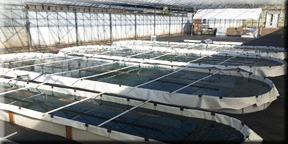Entries • 1) Algae Landscape Design
PAGE 2 ENTRIES #1160 to #2119
GO BACK to Page 1 LANDSCAPE DESIGN ENTRIES #1113 to #1159
CLICK ON IMAGE or Registration Number to see larger version of exhibit.
 1160. Kevin Le.
1160. Kevin Le.
The Silo-de-Sac. Carbon Recycling Structure, Los Angeles.
Developed in the early 20th century, the cul-de-sac was used
to slow traffic within a community and the many cul-de-sacs near LAX Airport today remain vacant and unused. Silo-de-Sac houses autos, siphons CO2 to feed algae which creates biofuel on the exterior skin.
 1161. Aleksandrina Rizova & Richard Beckett.
1161. Aleksandrina Rizova & Richard Beckett.
[Infra]Structural Algae Ecology for Taipei, Taiwan.
Rain-water will be harvested through the porous urban fabric and recycled for horizontal and vertical farming. Algal photo-bioreactor towers will collect CO2 from vehicles and buildings. Horizontal layers of hydroponics systems will provide food for the city.
 1162. Peter Chen.
1162. Peter Chen.
Seaweed House in China.
Seaweed houses are traditional houses built with stones and roofed by seaweed. The seaweed house is cool in summer and warm in winter. It is typical ecological housing and should be protected and carried forward as a cultural heritage.
 1163. Hiram Boujaoude.
1163. Hiram Boujaoude.
Pier 27 Terminal with Hydroponic Skin, San Francisco Waterfront.
P.O.S.H – Port-Out-Starboard-Home will introduce the mass tourist to a surreal experience induced by a biomass skin which feeds the city. A gateway to sustainable practices with curved surfaces of photobioreactor panels with botyococcus braunii for biodiesel and agricultural gardens.
 1164. Sean Quinn.
1164. Sean Quinn.
Process Zero: Retrofit Resolution. Federal Building, Los Angeles.
Goal is to design zero environmental footprint, energy self-sufficiency for existing building using Living Building Challenge 2.0 guidelines. A modular system of algae tubes wrap the building and absorb the sun’s radiation to produce lipids for fuel production and shade the interior office spaces.
 1165. Federico Curiél.
1165. Federico Curiél.
ALGAL&SCAPE: Study of polder Schieveen, Rotterdam, Netherlands.
A sustainable strategy for large scale micro-algae harvesting using the polders, reclaimed land enclosed by dykes. The Netherlands could benefit from this transformation of the polders, ensuring enough production of fuel for the Dutch needs and even more to be stored or exported.
 1166. Video. Hannes Maier.
1166. Video. Hannes Maier.
The Green Pit and German Expo Pavilion 2015 Milan.
Many former coal mines in Germany are abandoned and flooded. This approach is to flood pit mines to use them as cultivated areas for microalgae. The “Green Pit” Pavilion represents past, present and future and consists of an oversized bio-reactor for micro-algae.
 1167. Mats Håkansson.
1167. Mats Håkansson.
Eco-Activism in Malmo, Sweden.
An awareness and air purification installation on the Amirals Bridge. It is an attractor that pronounces itself through phenomenological impression, in a way that will touch, attract or maybe repel. In daytime the sails follow the sun, and at night, glowing and interacting with the passerby.
 1168. Greg Barton.
1168. Greg Barton.
Automated Bloom: Bio-Farming in the Gulf of Mexico, Louisiana.
This self-replicating floating algae farm is composed of robotic bio-plastic photo-bioreactor tubes in hexagons. The project will oxygenate dead zones in the Gulf, utilizing the heavy loads of nitrogen and phosphorous and capturing CO2 emissions from plants in Texas and Louisiana.
 1169. Carly Martin.
1169. Carly Martin.
Freeway Lungs: Darling Harbour, Sydney Australia.
Breathing life back into our cities. Freeway overpass will be encased in an algal membrane that absorbs pollution and reduces noise. Algae turns the polluted water from the harbour into hydrogen gas for fueling cars. Clean water is used under the freeway to farm edible algae nori and wakame.
 1170. Chew Teik Hee.
1170. Chew Teik Hee.
PAM (Persatuan Arkitek Malaysia) Centre, Malaysia
As a living entity this building becomes the breathable Malaysian Institute of Architects. The outer skin is a glass shell structure reinforced with octagonal frames and perforated with controllable openings. Modular bio-reactor panels are along the inner facade and algae within the panels.
 1171. Kady, Wong Hoi Kei & Kate, Lau Hoi Ying & Perry Li.
1171. Kady, Wong Hoi Kei & Kate, Lau Hoi Ying & Perry Li.
Urban Algae Culture in Gangxiacun, Shenzhen China.
The Urban River from waste to source. Masterplan for an urban village of 20,000 people in Shenzhen city of 14 million people. Redesign with an elevated urban river roofscape, greening with modular algae units for waste treatment and fuel production, urban farming, community space.
 1172. Video. Squared Design Lab: & Höweler+Yoon Architecture.
1172. Video. Squared Design Lab: & Höweler+Yoon Architecture.
Eco-Pod: Pre-Cycled Modular Algae Bioreactor, Boston.
Eco-Pod is a temporary vertical algae bioreactor and public commons, built with custom prefab modules. The pods are biofuel sources and micro-incubators for R&D programs. This is anticipatory architecture, generating a micro-urbanism that is local, agile, and carbon net positive.
 1173. Adrian Yee Cheung Lo.
1173. Adrian Yee Cheung Lo.
Carbon Dioxide Eliminating Floating Green Park, Hong Kong.
Rule of Nature: Waste is Food. The site is a shore front express way next to the dense urban residential developments in Hong Kong. A CO2 collector system integrated with noise barrier. Car exhaust CO2 is pumped to algae cell modules for hydrogen-producing marine algae.
 1174. Sarah Hobstetter.
1174. Sarah Hobstetter.
Site Siphon Biofuel Homes, Redwood City, San Francisco Bay
Pink and orange salt manufacturing ponds host halophilic (salt-loving) algae- the inspiration for Site Siphon, a housing development with a program of housing and bio-fuel production. Like a giant catamaran, housing pods siphon water from ponds to grow algae for bio-fuel.
 1175. Tolga Hazan.
1175. Tolga Hazan.
Project Bio-Slum, Jakarta, Indonesia.
Located in the wetland of WadukPluit in the Jakarta Penjaringan slums, Bio-Slum offers an alternative to palm oil for biodiesel. The project works in the urban landscape, avoiding deforestation, and fuses algae into daily activities, with an upper green layer shading residents below.
 1176. Nathan Smith.
1176. Nathan Smith.
Algal Filter Machine, Los Angeles.
Targets the areas of greatest CO2 emission and employs energy-producing systems at varying scales to foster the growth of algal bio-fuel. 1) Recursive Car: growing gasoline. 2) Algae Power Plant: growing electricity. 3) Los Angeles River Stations: growing fuel for an entire city.
 1177. Olga Kozachek, Erin Avera, Audrey Galo.
1177. Olga Kozachek, Erin Avera, Audrey Galo.
Algal Urbanism: 50 Year Master Plan for Alameda Air Base.
Decommissioned since the 1970s, polluted and mostly abandoned, the redevelopment of this site on San Francisco Bay includes remediation of habitat and wetlands, infrastructure, tunnels and towers to sustain re-population and algae production for biofuel.
 1178. Video. Melanie Hammer.
1178. Video. Melanie Hammer.
ECO2 Systems- Algaegardens in the old salt works of Cadiz, Spain.
In the unused salt works, algae is combined with crops of salt, farmed fish and saline agriculture for algae biofuel and hydrogen, food, building materials, bioplastics, dyes, pigments, medicine, cosmetics and fertilizer. Microalgae farms are air filters and macroalgae farms are water filters.
 1179. Ho Wing Ho.
1179. Ho Wing Ho.
Production Landscape for warm coastal areas of the world.
The offshore algae cell farm powers the city nearby and its by-products benefit onshore agriculture. Rings of floating hydrogen producing algae cells in daytime produce electricity and are inflated by gases. At night, the gases inflate onshore greenhouses as heat for plants inside.
 1180. Heather Ring, Brenda Parker, Synnove Fredericks.
1180. Heather Ring, Brenda Parker, Synnove Fredericks.
Algaegarden celebrates the beauty and productive potential of algae.
Algaegarden leads the visitor to appreciate algae both as an alternative to oil and a source of food and nutrition. Bicycle pumps invite visitors to participate in the aerating the algae. The garden was selected to be part of the 2011 Metis International Garden Festival in Quebec.
 1181. Wiryadi Sabdatama, Islamic University of Indonesia.
1181. Wiryadi Sabdatama, Islamic University of Indonesia.
The Algae Bridge: Winongo Riverbank, Indonesia
Kampung Algae: an algae village community in the densely populated township of Yogyakarta. Algae Bridge utilizes water as algae growing media to support production, improve water quality and increase open space. Also featuring vertical algae panels on village house walls.
 1182. Judit Aragonés Balboa.
1182. Judit Aragonés Balboa.
Alga Therapeia Center, San Sebastian, Spain.
Design for a research center of marine algae typical of the Basque
coast for medicinal, food and industrial applications. A photobioreactor skin generates the necessary energy for all building operations: therapy baths, solarium, kitchens, classrooms, research laboratory.
 1183. Catherine deAlmeida.
1183. Catherine deAlmeida.
Energy Afterlife to Energy [Re]Production, Reykjanes, Iceland.
Choreographing Algae, Plants, and People with Geothermal Effluent. Creating a new landscape using the heat now diverted to the ocean. Utilizing three different programs: algae cultivation, re-vegetation strategies, human use and interaction in a thermal resource park.
 1184. Scott Abercrombie, University of Strathclyde.
1184. Scott Abercrombie, University of Strathclyde.
Seaweed Ethanol Distilleries in Scotland.
Macro-Algae in the Micro Community: Utilising Scotland’s natural resources to generate sustainable economies. To reverse the decline in the Scottish Seaweed Industry, this project proposes a new output: ethanol biorefineries in differing scales of communities.
 1185. Mark Buehrer, 2020 Engineering Inc.
1185. Mark Buehrer, 2020 Engineering Inc.
Eco Laboratory: Phase II Algae Microfarm Center, Seattle.
The Algae Microfarm Center is the heart of the community. A living building with algaculture, hydroponics, aquaculture, aeroponics, aquaponics and farming. Includes rooftop garden, algae bioreactors, farmers market, community gardens, orchards and greenhouses.
 1186. Thomas Kosbau.
1186. Thomas Kosbau.
Hydral Housing units with modular hydrogen producing panels.
Modular panels of hydrogen producing algae can be placed like photo-voltaics. This second skin of algae panels constructs a quilted mosaic of color. Housing units create fresh water and reduce carbon emissions, without requiring occupants to change energy-consuming habits.
 1187. Algae Connects, Norbert Hoeller and team.
1187. Algae Connects, Norbert Hoeller and team.
Stimulating a Future of Growth for Recovering Communities, Haiti.
Algae Connects is a systems solution for clean water and food production in communities affected by disasters. One component is the algae connector, a device that uses algae to absorb water pollutants, filters algae from the water and transports the cleaned water.
 1188. Isla Marshall.
1188. Isla Marshall.
Algae Biofueled Thames Pilotage Station, Millwall Dock, London.
This algae bio-fueled Thames River pilotage station can handle 12 launch boats along its floating jetty with marine algae biofuel stations. Floating boat-like architecture with bioreactor panel wall, algae cuisine dining area, courtyard, garden, pool and accommodations.
 1189. Ivan Chang.
1189. Ivan Chang.
Varsity Think Tank in Oxbridge, England.
A proposal comprised of a new rail link within the disjointed Varsity Line with a research platform based on experimental water-based infrastructure. The research program is based on the extended hydrocycle of the algae photo-bioreactor and other water-based technologies.
 1190. Video. Influx_Studio, Mario Caceres, Christian Canonico.
1190. Video. Influx_Studio, Mario Caceres, Christian Canonico.
Green Loop: Marina City Global Algae Retrofitting, Chicago.
Algae proposal for one of the most innovative buildings in the Loop of Chicago: Marina City Towers. Aligned with the Chicago Climate Action Plan (2008), goal is to showcase algae with green technologies and clean polluted air, reuse waste water, produce energy and food onsite.
 1191. Karolina Malecha.
1191. Karolina Malecha.
Green Vision for Eco-Communities: Self-Efficient Algae Lamp Post.
This multifunctional lamp post would deliver lighting at night, filter water at the local level, feed from natural sources (rivers) or gray water, provide biofuel, reduce carbon dioxide and produce oxygen. Its shape could be designed reflecting different cultures and communities.
 2119. UPI-2M: A. Plestina, I. Zmisa, S, Marenic, M. Nikic, M. Gornik.
2119. UPI-2M: A. Plestina, I. Zmisa, S, Marenic, M. Nikic, M. Gornik.
BioOctonic Utility Tower, Zagreb, Croatia.
Designed for any city, these vertical farming towers are designed for production of bio-fuel and city air recuperation, and placed on existing petrol stations. First façade layer of the tower comes is glass outer skin layer which is a tubular system for the growth of algae.
GO BACK to Page 1 LANDSCAPE DESIGN ENTRIES #1113 to #1159

 SF Bay Area Spirulina Microfarm
SF Bay Area Spirulina Microfarm



